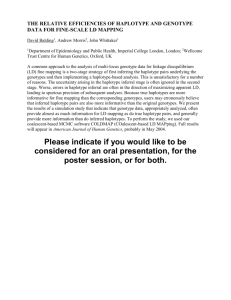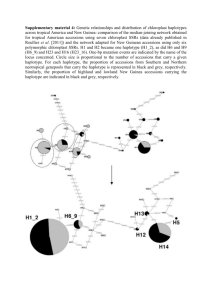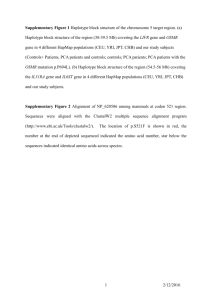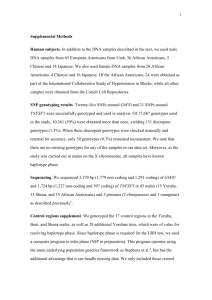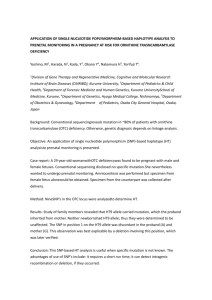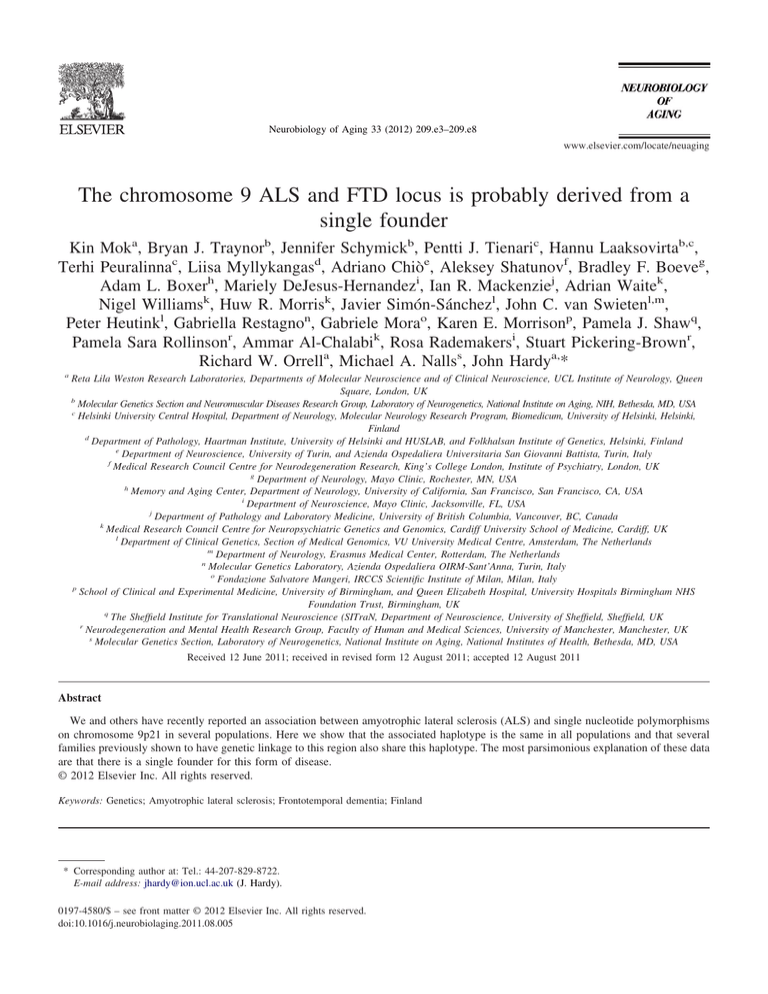
Neurobiology of Aging 33 (2012) 209.e3–209.e8
www.elsevier.com/locate/neuaging
The chromosome 9 ALS and FTD locus is probably derived from a
single founder
Kin Moka, Bryan J. Traynorb, Jennifer Schymickb, Pentti J. Tienaric, Hannu Laaksovirtab,c,
Terhi Peuralinnac, Liisa Myllykangasd, Adriano Chiòe, Aleksey Shatunovf, Bradley F. Boeveg,
Adam L. Boxerh, Mariely DeJesus-Hernandezi, Ian R. Mackenziej, Adrian Waitek,
Nigel Williamsk, Huw R. Morrisk, Javier Simón-Sánchezl, John C. van Swietenl,m,
Peter Heutinkl, Gabriella Restagnon, Gabriele Morao, Karen E. Morrisonp, Pamela J. Shawq,
Pamela Sara Rollinsonr, Ammar Al-Chalabik, Rosa Rademakersi, Stuart Pickering-Brownr,
Richard W. Orrella, Michael A. Nallss, John Hardya,*
a
Reta Lila Weston Research Laboratories, Departments of Molecular Neuroscience and of Clinical Neuroscience, UCL Institute of Neurology, Queen
Square, London, UK
b
Molecular Genetics Section and Neuromuscular Diseases Research Group, Laboratory of Neurogenetics, National Institute on Aging, NIH, Bethesda, MD, USA
c
Helsinki University Central Hospital, Department of Neurology, Molecular Neurology Research Program, Biomedicum, University of Helsinki, Helsinki,
Finland
d
Department of Pathology, Haartman Institute, University of Helsinki and HUSLAB, and Folkhalsan Institute of Genetics, Helsinki, Finland
e
Department of Neuroscience, University of Turin, and Azienda Ospedaliera Universitaria San Giovanni Battista, Turin, Italy
f
Medical Research Council Centre for Neurodegeneration Research, King’s College London, Institute of Psychiatry, London, UK
g
Department of Neurology, Mayo Clinic, Rochester, MN, USA
h
Memory and Aging Center, Department of Neurology, University of California, San Francisco, San Francisco, CA, USA
i
Department of Neuroscience, Mayo Clinic, Jacksonville, FL, USA
j
Department of Pathology and Laboratory Medicine, University of British Columbia, Vancouver, BC, Canada
k
Medical Research Council Centre for Neuropsychiatric Genetics and Genomics, Cardiff University School of Medicine, Cardiff, UK
l
Department of Clinical Genetics, Section of Medical Genomics, VU University Medical Centre, Amsterdam, The Netherlands
m
Department of Neurology, Erasmus Medical Center, Rotterdam, The Netherlands
n
Molecular Genetics Laboratory, Azienda Ospedaliera OIRM-Sant’Anna, Turin, Italy
o
Fondazione Salvatore Mangeri, IRCCS Scientific Institute of Milan, Milan, Italy
p
School of Clinical and Experimental Medicine, University of Birmingham, and Queen Elizabeth Hospital, University Hospitals Birmingham NHS
Foundation Trust, Birmingham, UK
q
The Sheffield Institute for Translational Neuroscience (SITraN, Department of Neuroscience, University of Sheffield, Sheffield, UK
r
Neurodegeneration and Mental Health Research Group, Faculty of Human and Medical Sciences, University of Manchester, Manchester, UK
s
Molecular Genetics Section, Laboratory of Neurogenetics, National Institute on Aging, National Institutes of Health, Bethesda, MD, USA
Received 12 June 2011; received in revised form 12 August 2011; accepted 12 August 2011
Abstract
We and others have recently reported an association between amyotrophic lateral sclerosis (ALS) and single nucleotide polymorphisms
on chromosome 9p21 in several populations. Here we show that the associated haplotype is the same in all populations and that several
families previously shown to have genetic linkage to this region also share this haplotype. The most parsimonious explanation of these data
are that there is a single founder for this form of disease.
© 2012 Elsevier Inc. All rights reserved.
Keywords: Genetics; Amyotrophic lateral sclerosis; Frontotemporal dementia; Finland
* Corresponding author at: Tel.: 44-207-829-8722.
E-mail address: jhardy@ion.ucl.ac.uk (J. Hardy).
0197-4580/$ – see front matter © 2012 Elsevier Inc. All rights reserved.
doi:10.1016/j.neurobiolaging.2011.08.005
209.e4
K. Mok et al. / Neurobiology of Aging 33 (2012) 209.e3–209.e8
1. Introduction
Amyotrophic lateral sclerosis (ALS) is a fatal neurodegenerative disease affecting motor neurons characterized by
rapidly progressive weakness and ultimately death from
respiratory failure typically within 3 years of symptom
onset. Understanding the genetic etiology of the disease has
been a focus for the ALS research community, as each new
gene provides fundamental insights into the pathogenesis of
motor neuron degeneration, as well as accelerating disease
modeling and the design and testing of targeted therapeutics.
Using a genome-wide association study (GWAs) approach, we recently reported that a locus on chromosome
9p21 accounted for ⬎ 40% of familial ALS and nearly
1-fourth of all ALS cases in a sample of 405 Finnish
patients (Laaksovirta et al., 2010). This association signal
had previously been reported by van Es et al. (2009) as
showing association with ALS and a meta-analysis amongst
many studies showed that this was indeed the major signal
for this disease (Shatunov et al., 2010). Similarly, a recent
GWAs for frontotemporal dementia (FTD) with TDP-43
pathology had also identified this locus (Van Deerlin et al.,
2010).
Linkage analysis of kindreds affected with multiple cases
of ALS, FTD, and FTD-ALS with type 2 TDP-43 pathology
had suggested there was an important locus for the disease
on chromosome 9p (Boxer et al., 2011; Morita et al., 2006;
Pearson et al., 2011; Vance et al., 2006) but it had not been
clear whether the linkage and association signals related to
a single locus or whether the different studies were reporting the same alleles at that locus.
The analysis in the Finnish population had narrowed the
association signal to a 232 kb block of linkage disequilibrium, and allowed the identification of a haplotype that
increased risk of disease by over 20-fold. Despite considerable efforts in our laboratories and others the underlying
causative variant and deleterious mutation has not yet been
identified.
Here, we examine the prevalence of the Finnish risk
haplotype in other European populations to determine its
geographical distribution and to analyze the possibility that
it represents a founder mutation. We then tested this haplotype in ALS and FTD families with evidence of linkage to
this region to determine if the same haplotype is responsible
for both ALS and FTD. In the 4 families for which we had
access to primary genetic data, the haplotype was consistent
with the Finnish one.
2. Methods
We analyzed GWAs data obtained for ALS patients and
neurologically normal controls in 5 populations in which we
have access to the raw genotype data. These are the Finnish
dataset (Laaksovirta et al., 2010), the Irish dataset (Cronin et
al., 2008), the UK dataset (Shatunov et al., 2010), the US
dataset (Schymick et al., 2007), and the Italian dataset (Chiò
et al., 2009). All cohorts had been genotyped using Illumina
(San Diego, CA, USA) single nucleotide polymorphism
(SNP) arrays. Standard quality control procedures were
applied to each dataset prior to combining summary statistics for meta-analysis. In brief, samples were excluded if
they had call rates less than 95%, phenotype-genotype gender discordance, demonstrated cryptic relatedness (defined
as pi_hat greater than 12.5%, effectively removing all first or
second degree relatives), or outliers from the populations with
European ancestry (defined as ⬎ 3 standard deviations away
from the combined European Caucasians [HapMap 3 release 3,
2010 (International HapMap 3 Consortium, 2010)] population
mean in components vectors 1 and 2, using PLINK Multidimensional scaling plot). SNPs were excluded if they had a
minor allele frequency (MAF) ⬍ 0.01, Hardy-Weinberg equilibrium p-value ⬍ 10⫺6 in controls, missing by haplotype p
value ⬍ 10⫺4, or evidence of nonrandom missingness in
cases versus controls (p value ⬍ 10⫺4). Meta-analyses were
performed with METAL (Willer et al., 2010) for fixedeffect and PLINK (Purcell et al., 2007) for random-effects
model. Haplotype analysis was performed using Haploview 4.2 to evaluate the possibility of population-based
differences (Barrett et al., 2005). Additional statistical
analyses were performed using R (version 2.11.1, R Development Core Team, 2010). Subsequently, we tested
families where phased genotype data generated on various SNP chips was available to establish the relationship
between the 9p21 susceptibility region and the Mendelian
linkage regions.
3. Results
We performed a meta-analysis of 5 ALS genome-wide
association studies involving a total of 2017 cases and 3639
controls drawn from the 5 datasets. As expected, metaanalysis confirmed the presence of previously identified
locus on chromosome 9p21 (most significantly with imputed SNP ⫽ rs2477521, p value ⫽ 4.51 ⫻ 10⫺11 based on
fixed-effect model with heterogeneity p value of 1.5 ⫻
10⫺4, and an overall p value ⫽ 0.00876 based on more
conservative random-effects model). Heterogeneity estimates suggested significant variation in the effect size from
different populations, with the Italian population being a
frequent outlier. Secondary analysis without the Italian cohort yielded a markedly more robust p value for the same
SNP (p value for rs2477521 under the fixed effect model ⫽
1.24 ⫻ 10⫺13; rs10967973 with p value under the random
effects model ⫽ 1.55 ⫻ 10⫺10). This suggests that the effect
at this SNP differs markedly when comparing between
populations of Northern and Southern European ancestry.
The original risk haplotype identified within the Finnish
ALS population consisted of 42 SNPs stretching over a 232
kb region of chromosome 9p21 (Laaksovirta et al., 2010).
This block of linkage disequilibrium was shorter in the
K. Mok et al. / Neurobiology of Aging 33 (2012) 209.e3–209.e8
Table 1
Twenty SNP haplotype frequencies in cases and controls
Population
Number
(case:control)
Frequency
Case
Control
Finland
Ireland
Italy
UK
USA
405:497
221:211
500:247
620:1890
271:794
0.23
0.147
0.129
0.182
0.145
0.098
0.116
0.149
0.135
0.111
209.e5
4. Discussion
p
3.169E-14
0.1716
0.3183*
9.17E-05
0.0443
Haplotype frequencies in cases and controls and the p-value (2) for the
nominal significance of the difference between them. The 20 SNPs are:
rs1822723, rs4879515, rs868856, rs7046653, rs1977661, rs903603,
rs10812610, rs2814707, rs3849942, rs12349820, rs10122902, rs10757665,
rs1565948, rs774359, rs2282241, rs1948522, rs1982915, rs2453556,
rs702231, and rs696826.
Key: SNP, single nucleotide polymorphism.
* In contrast to the other populations, the Italian cases have a marginally
decreased frequency of the risk haplotype.
European Caucasians HapMap data (24 SNPs over a 140
kb region), as would be expected in an outbred European
population compared with the genetically homogeneous
Finnish population (Shifman and Darvasi, 2001). Of
these 24 SNPs, only 21 had been genotyped in all 5
populations. Furthermore, the most centromeric SNP of
these 21 (rs1444533) did not show convincing association with disease in either the UK or Irish population.
This SNP was therefore dropped from subsequent analysis, leaving a 20 SNP risk haplotype common to all
Northern European ancestry groups in this meta-analysis.
Thus, we restricted subsequent analyses to the region
chr9: 27467874-27579657 (NCBI36/hg18) between SNP
rs1444533 and rs696826.
This 20 SNP haplotype was associated with disease in
Finland, was less significantly associated in the UK and US
populations (Table 1); this haplotype had only a trend toward association in the Irish population (p ⫽ 0.17) and
showed no evidence of association at all in the Italian
population. The 20 SNP haplotype is consistent with the
association recently reported for both FTD (Van Deerlin et
al., 2010; Rollinson et al., 2011; see Table 2) and for ALS
in a Dutch study although the incompleteness of the published data in these studies precludes a formal comparison.
Analysis of SNP chip data in 4 families with FTD or
FTD-ALS (Boxer et al., 2011; Pearson et al., 2011; Seelaar
et al., 2011; Traynor and Hardy, unpublished) in which
linkage data was generated using SNP chips (Table 2)
revealed that a similar disease haplotype was found in all
patients with the exception of the most distal SNP
(rs2477518) in the family reported by Seelaar et al. (2011).
These data suggest that the same conserved chromosome
9p21 20 SNP risk haplotype underlies both ALS and FTD in
multiple populations and that a proportion at least of the
families showing genetic linkage to the region also share
this rather short haplotypic region.
These results are consistent with a single haplotype being
associated with ALS, FTD, and FTD-ALS in most of the
populations studied with the strength of the association
being strongest in populations from Northern Europe that
exhibit some estimated degree of Scandinavian ancestry and
progressively weaker as one moves south and the contribution of this ancestral background is reduced. This interpretation is also consistent with the data from van Es et al.
(2009) who first identified this association and showed a
stronger association in a Swedish population than in the
others included in their analysis (note that this analysis
partially overlaps with our analysis reported here). This
haplotype has the structure shown in Table 2 and extends
over 140 kb and 3 genes MOBKL2B, C9orf72, and IFNK.
Although this is the simplest explanation it is worth considering what other explanations would be consistent with
the data. One such explanation is that the haplotype carries
a premutation (such as an expanded repeat) which is predisposed to give rise independently to pathogenic alleles of
differing penetrances.
The observations described above have several implications. First, if only a single founding haplotype bears the
mutation this suggests that all, or at least the majority of
individuals, with the disease possess the same pathogenic
variant. Second, the lack of pathogenic coding mutations in
the known genes within this locus suggests that the mutation(s) is of an unusual type involving something other than
a simple missense or nonsense change. Possibilities would
include inversions similar to the MAPT H2 haplotype, or
the inclusion of cryptic exons or the exclusion of exons
caused by variants distant from splice sites. Third, it seems
that the same associated haplotype is found in both FTD and
ALS. In this latter regard, it is interesting that, whereas a
founder mutation of the MAPT gene largely explains the
Manchester focus of FTD (Pickering-Brown et al., 2002)
the well documented Lund focus of FTD in Sweden remains
unexplained. Fourth, our data are consistent with the same
haplotype being responsible for the disease in families
showing linkage to this region suggesting they harbor the
same pathogenic mutation: certainly this is the case in those
families to which we have access. By explicitly publishing
this haplotype, our data will enable those who have access
to other families to assess whether this same haplotype is
present in their families. It remains unclear as to why the
apparent penetrance of the haplotype appears to be so variable. It could be that this reflects ascertainment bias, or that
there have been subsequent additional variants accrued onto
this ancient haplotype, or it could be that there is another
epistatic locus elsewhere in the genome which influences
penetrance as Gijselinck and colleagues have suggested
(2010).
Clearly, the identification of this locus remains a major goal of ALS and FTD research. Our data suggest that
209.e6
Table 2
The 24-SNP Finnish haplotype compared with 20 SNP haplotype and data from other populations, families, and publications
SNP
This study
Irish
US
UK
Italian
Consensus
20 SNP
haplotype
Previous association studies
Finnish
Van Es et al.
(2009)
Van Deerlin
et al. (2010)
Rollinson
et al.
(2011)
Data from families
Boxer et al.
(2011)
Seelaar et al.
(2011)
Pearson et al.
(2011)
US number
3 (Traynor
and Hardy,
unpublished)
27467874
27468052
27472235
27473959
27479251
27480967
27485418
27492986
27519316
27523984
27526397
27533281
27543876
27546780
27547919
27549733
27551049
27562255
27565785
27569560
27574530
27576162
27578731
27579657
27589746
A
C
T
T
T
A
A
C
C
C
A
A
T
G
T
G
C
G
C
G
A
C
T
—
T
A
—
C
C
C
A
A
T
G
T
G
C
G
C
G
A
C
T
T
T
A
A
C
C
C
A
A
—
G
T
G
C
G
C
G
A
C
T
T
T
A
A
C
C
C
A
A
—
G
T
G
C
G
C
G
Aa
C
T
—
T
A
—
C
C
C
A
A
—
G
T
G
C
G
C
G
—
—
—
—
—
—
—
—
—
—
A
A
—
—
—
—
—
—
—
—
—
—
—
—
—
—
—
—
—
—
A
A
—
—
—
—
C
—
—
—
—
—
—
T
T
—
A
C
C
C
A
A
—
G
T
G
—
G
C
—
A
C
T
T
T
A
A
C
C
C
A
A
T
G
T
G
C
G
C
G
A
C
T
T
T
A
A
C
C
C
—
—
T
G
—
—
—
G
C
G
T
—
T
T
T
A
A
C
C
C
A
A
T
G
T
G
C
G
C
G
A
—
T
T
T
A
A
C
C
C
A
A
T
G
T
G
C
G
C
G
G
A
G
T
G
A
G
T
G
A
G
T
A
C
T
T
T
A
A
C
C
C
A
A
T
G
T
G
C
G
C
G
T/C
G
A
G
T/C
G
A
G
T
G
A
G
—
—
—
—
—
—
—
—
—
—
—
—
G
A
G
T
G
A
G
C
G
A
G
T
G
A
G
T
Haplotype deduced directly from array genotyping (this study) or haplotype given or deduced from previous publications, or haplotype derived from linkage analysis of families we have analyzed. Imputed
SNP genotypes are not given. [—] indicates genotype not assessed or not clear because of ambiguous phase. The family US number 3 has not been published but has a phenotype consistent with other families
with this phenotype and a lod score of ⬎ 1.2 with chromosome 9 markers. Note the discrepant results for Pearson et al. rs1444533 (centromeric) and Boxer et al. rs2477518 (telomeric) which suggest definitive
flanking SNPs for the locus. SNPs included in the haplotype analysis are in bold.
Key: ch9, chromosome 9; SNP, single nucleotide polymorphism.
a
rs1444533 was dropped from the 20 SNP haplotype analysis.
K. Mok et al. / Neurobiology of Aging 33 (2012) 209.e3–209.e8
rs1444533
rs1822723
rs4879515
rs895023
rs868856
rs7046653
rs2440622
rs1977661
rs903603
rs10812610
rs2814707
rs3849942
rs12349820
rs10122902
rs10757665
rs1565948
rs774359
rs2282241
rs1948522
rs1982915
rs7868845
rs2453556
rs702231
rs696826
rs2477518
Position
on ch9
K. Mok et al. / Neurobiology of Aging 33 (2012) 209.e3–209.e8
this will be a difficult task and will require complete
sequencing of the locus and of all the transcripts emanating from it.
Disclosure statement
The authors disclose no conflicts.
Appropriate Ethical Committee approvals were in place
for this work.
Acknowledgements
This work was supported in part by the Intramural Research Programs of the NIH, the National Institute on Aging
(Z01-AG000949-02), and the National Institute on Neurological Disorders and Stroke. Extramural NIH grants
R01AG031278, R01AG038791 supported some family assessments: NIH/NIA grant R01 AG26251 (RR) funded
some analytical work. The research leading to these results
has received funding from the European Community’s
Health Seventh Framework Programme (FP7/2007-2013)
under grant agreement n° 259867. The authors thank the
Motor Neurone Disease Association of Great Britain for
several grants relating to this work (RWO, AAC, PJS, HM),
the ALS Association, The Angel Fund, the ALS Therapy
Alliance, and the Wellcome Trust (PJS) for support.This
work was also funded by the Reta Lila Weston Foundation,
and by an MRC returning scientist (JH) and fellowship
(SPB) award, by Microsoft Research Foundation, the ALS
Association, Helsinki University Central Hospital, and the
Finnish Academy. This work was also funded by Ministero
della Salute, Progetti Finalizzati 2007, Fondazione Vialli e
Mauro for ALS, and Federazione Italiana Giuoco Calcio.
The authors also thank the Hersenstichting Nederland
(www.hersenstichting.nl) for supporting this work. The authors thank the NIHR specialist Biomedical Research Centre for Mental Health at the South London and Maudsley
NHS Foundation Trust (SLaM) and the Institute of Psychiatry, King’s College London as well as the NIHR-funded
UCL/UCLH Comprehensive Biomedical Research Centre.
Appendix A. Supplementary data
Supplementary data associated with this article can be
found, in the online version, at doi:10.1016/j.neurobiolaging.
2011.08.005.
References
Barrett, J.C., Fry, B., Maller, J., Daly, M.J., 2005. Haploview: analysis and
visualization of LD and haplotype maps. Bioinformatics 21, 263–2635.
Boxer, A.L., Mackenzie, I.R., Boeve, B.F., Baker, M., Seeley, W.W.,
Crook, R., Feldman, H., Hsiung, G.Y., Rutherford, N., Laluz, V.,
Whitwell, J., Foti, D., McDade, E., Molano, J., Karydas, A., Wojtas,
A., Goldman, J., Mirsky, J., Sengdy, P., Dearmond, S., Miller, B.L.,
Rademakers, R., 2011. Clinical, neuroimaging and neuropathological
features of a new chromosome 9p-linked FTD-ALS family. J. Neurol.
Neurosurg., Psychiatry 82, 196 –203.
209.e7
Chiò, A., Schymick, J.C., Restagno, G., Scholz, S.W., Lombardo, F., Lai,
S.L., Mora, G., Fung, H.C., Britton, A., Arepalli, S., Gibbs, J.R., Nalls,
M., Berger, S., Kwee, L.C., Oddone, E.Z., Ding, J., Crews, C., Rafferty, I., Washecka, N., Hernandez, D., Ferrucci, L., Bandinelli, S.,
Guralnik, J., Macciardi, F., Torri, F., Lupoli, S., Chanock, S.J.,
Thomas, G., Hunter, D.J., Gieger, C., Wichmann, H.E., Calvo, A.,
Mutani, R., Battistini, S., Giannini, F., Caponnetto, C., Mancardi, G.L.,
La Bella, V., Valentino, F., Monsurrò, M.R., Tedeschi, G., Marinou,
K., Sabatelli, M., Conte, A., Mandrioli, J., Sola, P., Salvi, F., Bartolomei, I., Siciliano, G., Carlesi, C., Orrell, R.W., Talbot, K., Simmons, Z., Connor, J., Pioro, E.P., Dunkley, T., Stephan, D.A., Kasperaviciute, D., Fisher, E.M., Jabonka, S., Sendtner, M., Beck, M., Bruijn,
L., Rothstein, J., Schmidt, S., Singleton, A., Hardy, J., Traynor, B.J.,
2009. A two-stage genome-wide association study of sporadic amyotrophic lateral sclerosis. Hum. Mol. Genet. 18, 1524 –1532.
Cronin, S., Berger, S., Ding, J., Schymick, J.C., Washecka, N., Hernandez,
D.G., Greenway, M.J., Bradley, D.G., Traynor, B.J., Hardiman, O.,
2008. A genome-wide association study of sporadic ALS in a homogenous Irish population. Hum. Mol. Genet. 17, 768 –774.
Gijselinck, I., Engelborghs, S., Maes, G., Cuijt, I., Peeters, K., Mattheijssens, M., Joris, G., Cras, P., Martin, J.J., De Deyn, P.P., Kumar-Singh,
S., Van Broeckhoven, C., Cruts, M., 2010. Identification of 2 Loci at
chromosomes 9 and 14 in a multiplex family with frontotemporal lobar
degeneration and amyotrophic lateral sclerosis. Arch. Neurol. 67, 606 –
616.
International HapMap 3 Consortium, Altshuler, D.M., Gibbs, R.A., and
other authors, 2010. Integrating common and rare genetic variation in
diverse human populations. Nature 467, 52–58.
Laaksovirta, H., Peuralinna, T., Schymick, J.C., Scholz, S.W., Lai, S.L.,
Myllykangas, L., Sulkava, R., Jansson, L., Hernandez, D.G., Gibbs,
J.R., Nalls, M.A., Heckerman, D., Tienari, P.J., Traynor, B.J., 2010. A
substantial proportion of ALS in Finland is explained by the chromosome 9p21 locus. Lancet Neurol. 9, 78 – 85.
Morita, M., Al-Chalabi, A., Andersen, P.M., Hosler, B., Sapp, P., Englund,
E., Mitchell, J.E., Habgood, J.J., de Belleroche, J., Xi, J., Jongjaroenprasert, W., Horvitz, H.R., Gunnarsson, L.G., Brown, R.H., Jr., 2006.
A locus on chromosome 9p confers susceptibility to ALS and frontotemporal dementia. Neurology 66, 839 – 844.
Pearson, J.P., Williams, N.M., Majounie, E., Waite, A., Stott, J., Newsway,
V., Murray, A., Hernandez, D., Guerreiro, R., Singleton, A.B., Neal, J.,
Morris, H.R., 2011. Familial frontotemporal dementia with amyotrophic lateral sclerosis and a shared haplotype on chromosome 9p.
J. Neurol. 258, 647– 655.
Pickering-Brown, S.M., Richardson, A.M., Snowden, J.S., McDonagh,
A.M., Burns, A., Braude, W., Baker, M., Liu, W.K., Yen, S.H., Hardy,
J., Hutton, M., Davies, Y., Allsop, D., Craufurd, D., Neary, D., Mann,
D.M., 2002. Inherited frontotemporal dementia in nine British families
associated with intronic mutations in the tau gene. Brain 125, 732–751.
Purcell, S., Neale, B., Todd-Brown, K., Thomas, L., Ferreira, M.A.,
Bender, D., Maller, J., Sklar, P., de Bakker, P.I., Daly, M.J., Sham,
P.C., 2007. PLINK: a toolset for whole-genome association and population-based linkage analysis. Am. J. Hum. Genet. 81, 559 –575.
R Development Core Team, 2010. R: A Language and Environment for
Statistical Computing. R Foundation for Statistical Computing, Vienna,
Austria.
Rollinson, S., Mead, S., Snowden, J., Richardson, A., Rohrer, J., Halliwell,
N., Usher, S., Neary, D., Mann, D., Hardy, J., Pickering-Brown, S.,
2011. FTLD GWAS Replication confirms a risk locus shared with
ALS. Neurobiol. Aging 32, e1– e7.
Schymick, J.C., Scholz, S.W., Fung, H.C., Britton, A., Arepalli, S., Gibbs,
J.R., Lombardo, F., Matarin, M., Kasperaviciute, D., Hernandez, D.G.,
Crews, C., Bruijn, L., Rothstein, J., Mora, G., Restagno, G., Chiò, A.,
Singleton, A., Hardy, J., Traynor, B.J., 2007. Genome-wide genotyping
in amyotrophic lateral sclerosis and neurologically normal controls:
first stage analysis and public release of data. Lancet Neurol. 6, 322–
328.
209.e8
K. Mok et al. / Neurobiology of Aging 33 (2012) 209.e3–209.e8
Seelaar, H., Rohrer, J.D., Pijnenburg, Y.A., Fox, N.C., van Swieten, J.C.,
2011. Clinical, genetic and pathological heterogeneity of frontotemporal dementia: a review. J. Neurol. Neurosurg., Psychiatry 82, 476 – 486.
Shatunov, A., Mok, K., Newhouse, S., Weale, M.E., Smith, B., Vance, C.,
Johnson, L., Veldink, J.H., van Es, M.A., van den Berg, L.H., Robberecht, W., Van Damme, P., Hardiman, O., Farmer, A.E., Lewis,
C.M., Butler, A.W., Abel, O., Andersen, P.M., Fogh, I., Silani, V.,
Chiò, A., Traynor, B.J., Melki, J., Meininger, V., Landers, J.E., McGuffin, P., Glass, J.D., Pall, H., Leigh, P.N., Hardy, J., Brown, R.H., Jr.,
Powell, J.F., Orrell, R.W., Morrison, K.E., Shaw, P.J., Shaw, C.E.,
Al-Chalabi, A., 2010. Chromosome 9p21 in sporadic amyotrophic
lateral sclerosis in the UK and seven other countries: a genome-wide
association study. Lancet Neurol. 9, 986 –994.
Shifman, S., Darvasi, A., 2001. The value of isolated populations. Nat.
Genet. 28, 309 –310.
Van Deerlin, V.M., Sleiman, P.M., Martinez-Lage, M., Chen-Plotkin, A.,
Wang, L.S., Graff-Radford, N.R., Dickson, D.W., Rademakers, R.,
Boeve, B.F., Grossman, M., Arnold, S.E., Mann, D.M., PickeringBrown, S.M., Seelaar, H., Heutink, P., van Swieten, J.C., Murrell, J.R.,
Ghetti, B., Spina, S., Grafman, J., Hodges, J., Spillantini, M.G., Gilman, S., Lieberman, A.P., Kaye, J.A., Woltjer, R.L., Bigio, E.H.,
Mesulam, M., Al-Sarraj, S., Troakes, C., Rosenberg, R.N., White, C.L.,
3rd, Ferrer, I., Lladó, A., Neumann, M., Kretzschmar, H.A., Hulette,
C.M., Welsh-Bohmer, K.A., Miller, B.L., Alzualde, A., Lopez de
Munain, A., McKee, A.C., Gearing, M., Levey, A.I., Lah, J.J., Hardy,
J., Rohrer, J.D., Lashley, T., Mackenzie, I.R., Feldman, H.H., Hamilton, R.L., Dekosky, S.T., van der Zee, J., Kumar-Singh, S., Van
Broeckhoven, C., Mayeux, R., Vonsattel, J.P., Troncoso, J.C., Kril, J.J.,
Kwok, J.B., Halliday, G.M., Bird, T.D., Ince, P.G., Shaw, P.J., Cairns,
N.J., Morris, J.C., McLean, C.A., DeCarli, C., Ellis, W.G., Freeman,
S.H., Frosch, M.P., Growdon, J.H., Perl, D.P., Sano, M., Bennett, D.A.,
Schneider, J.A., Beach, T.G., Reiman, E.M., Woodruff, B.K.,
Cummings, J., Vinters, H.V., Miller, C.A., Chui, H.C., Alafuzoff, I.,
Hartikainen, P., Seilhean, D., Galasko, D., Masliah, E., Cotman, C.W.,
Tuñón, M.T., Martínez, M.C., Munoz, D.G., Carroll, S.L., Marson, D.,
Riederer, P.F., Bogdanovic, N., Schellenberg, G.D., Hakonarson, H.,
Trojanowski, J.Q., Lee, V.M., 2010. Common variants at 7p21 are
associated with frontotemporal lobar degeneration with TDP-43
inclusions. Nat. Genet. 42, 234 –239.
van Es, M.A., Veldink, J.H., Saris, C.G., Blauw, H.M., van Vught, P.W.,
Birve, A., Lemmens, R., Schelhaas, H.J., Groen, E.J., Huisman, M.H.,
van der Kooi, A.J., de Visser, M., Dahlberg, C., Estrada, K., Rivadeneira, F., Hofman, A., Zwarts, M.J., van Doormaal, P.T., Rujescu, D.,
Strengman, E., Giegling, I., Muglia, P., Tomik, B., Slowik, A., Uitterlinden, A.G., Hendrich, C., Waibel, S., Meyer, T., Ludolph, A.C.,
Glass, J.D., Purcell, S., Cichon, S., Nöthen, M.M., Wichmann, H.E.,
Schreiber, S., Vermeulen, S.H., Kiemeney, L.A., Wokke, J.H., Cronin,
S., McLaughlin, R.L., Hardiman, O., Fumoto, K., Pasterkamp, R.J.,
Meininger, V., Melki, J., Leigh, P.N., Shaw, C.E., Landers, J.E., AlChalabi, A., Brown, R.H., Jr., Robberecht, W., Andersen, P.M.,
Ophoff, R.A., van den Berg, L.H., 2009. Genome-wide association
study identifies 19p13.3 (UNC13A) and 9p21.2 as susceptibility loci
for sporadic amyotrophic lateral sclerosis. Nat. Genet. 41, 1083–1087.
Vance, C., Al-Chalabi, A., Ruddy, D., Smith, B.N., Hu, X., Sreedharan, J.,
Siddique, T., Schelhaas, H.J., Kusters, B., Troost, D., Baas, F., de Jong,
V., Shaw, C.E., 2006. Familial amyotrophic lateral sclerosis with frontotemporal dementia is linked to a locus on chromosome 9p13.2-21.3.
Brain 129, 868 – 876.
Willer, C.J., Li, Y., Abecasis, G.R., 2010. METAL: fast and efficient
meta-analysis of genomewide association scans. Bioinformatics 26,
2190 –2191.


